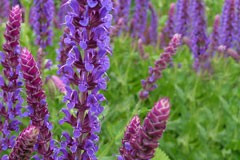
Viola odorata 'Swanley White'
Double white form, sweetly fragrant and lovely. Easy and clumping like other forms, best used in shade as ground cover.


A sub-species of Salvia nemorosa with larger leaves and flowers than the usual.
A sub-species of Salvia nemorosa with larger leaves and flowers than the usual.
Data sheet
Double white form, sweetly fragrant and lovely. Easy and clumping like other forms, best used in shade as ground cover.
Outstanding grey foliage plant for rock garden, border, or mass planting. Contrasts well with colourful foliage like berberis and cotinus, or in combination with Salvia nemorosa varieties. Yellow button flowers through summer, trim off if not your colour scheme!
Light blue form with larger flowers than the wild variety. Easy to grow and lovely in spring.
Evergreen rosette-forming penstemon with a tidy appearance and tall spikes of apricot flowers from summer to autumn.
Old fashioned "catmint", mostly used as a border or edging in cottage gardens. Soft blue flowers, trim lightly in mid summer for a repeat flower in autumn.
A pretty and long flowered plant for a damp soil in a sheltered position forms a nice clump. Grows well amongst other perennials or under roses.
Remarkable silver foliage plant, with vigourous trailing groundcovering habit; suits hanging basket or drystone wall. Extremely tough and adaptable.
Intermediate between Nepeta 'Walkers Low' and faasenii, bushy long flowering cultivar that repeat flowers well after trimming. Use as edging in cottage gardens instead of lavender. Flowers are lavender mauve in colour.
Tall growing ornamental grass, with attractive dark green foliage and feathery seedheads in summer.
Stunning double flowered paeonia requiring rich well drained soil in full sun, young plants often takes a year or two to establish but eventually form large clumps; we recommend removing first flowers to hasten establishment.
Cushion plant suitable for thyme lawns, trough, and rockgarden plantings with pink flowers. Aromatic when crushed.
Native of Georgia and Turkey growing in shady places by streams in deciduous forest. A beautiful evergreen plant producing delicate porcelain blue flowers in the early spring. Works well as a mass planting beneath trees with hellebores and Geranium phaeum.
A strong variety of bluebells that will colonize well in areas of shade or part sun, active mid winter and flowering spring to early summer, potted cluster of bulbs.
Old fashioned variety from Dennis Norgate with double red fragrant flowers, strong bushy grower with long enough stems to pick, without being fragile like many of the modern carnation varieties.
Old fashioned cottage plant with intense blue flowers, easily grown but best in clay based soil.
A wild Paeonia from the Caucasus from Ukraine to Romania with deep tomato red flowers and finely dissected foliage. This is a dwarf species which prefers fertile but drained conditions, and needs to dry off in summer after the growing period. A rare treasure.

A sub-species of Salvia nemorosa with larger leaves and flowers than the usual.